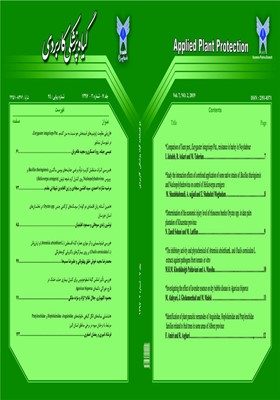ارزیابی مقاومت ژنوتیپهای امیدبخش جو نسبت به سن گندم، Eurygaster integriceps Put.، در شهرستان نیشابور
محورهای موضوعی : آفات گیاهیعیسی جبله 1 , رویا عسکری 2 , مجید طاهریان 3
1 - مدیر گروه گیاهپزشکی، جهاد دانشگاهی خراسان رضوی، موسسه آموزش عالی جهاد دانشگاهی کاشمر، کاشمر، ایران
2 - دانشجوی کارشناسی ارشد، حشره شناسی کشاورزی، جهاد دانشگاهی خراسان رضوی، مؤسسه آموزش عالی جهاد دانشگاهی کاشمر، کاشمر، ایران
3 - بخش تحقیقات زراعی و باغی، مرکز تحقیقات و آموزش کشاورزی و منابع طبیعی خراسان رضوی، سازمان تحقیقات، آموزش و ترویج کشاورزی، مشهد، ایران
کلید واژه: عملکرد, ژنوتیپ, شاخص تحمل, سن گندم,
چکیده مقاله :
جو یکی از اصلیترین منابع تأمین غذای انسان و دام در جهان است و سن گندم Eurygaster integricepsیکی از مهمترین آفات کاهش دهنده عملکرد آن می باشد. این بررسی بر روی ژنوتیپهای مختلف جو به منظور شناسایی ژنوتیپهای مقاوم به سن گندم در سالهای 1396 و 1397 در مرکز تحقیقات نیشابور انجام گرفته است. آزمایش در قالب طرح بلوک های کامل تصادفی در 3 تکرار اجرا شد. نتایج نشان داد که بیش ترین تعداد سن مادری در ژنوتیپ شماره 3 و کم ترین آن مربوط به ژنوتیپهای شماره 2 و 6 بود. ژنوتیپ 13 با برتری شاخص وزن هزار دانه در شرایط بدون سن و ژنوتیپ 10 با برتری شاخص وزن هزار دانه در شرایط وجود سن در ناحیه با پتانسیل تولید بالا و حساسیت پایین به سن قرار گرفتند. وزن هزاردانه در شرایط بدون فعالیت سن (Yp) همبستگی مثبت و معنی داری با میانگین بهره وری ((MP، میانگین هندسی (GMP) و شاخص تحمل به سن (STI) داشت. وزن هزار دانه در شرایط فعالیت سن (YS) همبستگی مثبت و معنی داری با تمام شاخص ها به جز YI داشت. بر این اساس شاخص های میانگین بهره وری (MP)، میانگین هندسی (GMP) و شاخص تحمل به سن (STI) تنها شاخص هایی بودند که همبستگـی مثبت و معنی داری با عملکرد دانه در شرایط فعالیت سن و عدم فعالیت سن داشتند. در نهایت می توان ژنوتیپ شماره 20 را به عنوان ژنوتیپ مقاوم به سن در منطقه نیشابور معرفی کرد و ژنوتیپ شماره 1 را، با وزن هزاردانه پایین، حساس به سن گزارش کرد.
Barley is one of the world's main sources of nutrients for human and animal, and E. integriceps is one of the most important pests reducing its yield. This study was conducted on different barley genotypes to identify the genotypes that are resistant to Sunn pest. The study was a randomized complete block design with three replications that was conducted in 2016 and 2017 in Neyshabour Agricultural Research Center. The results showed that the highest number of E. integriceps was recorded in genotype 3 and the lowest number of E. integriceps was related to genotypes 2 and 6. Genotype 13, with the important indices of grain yield under non-stress condition (Yp) and genotype 10, with the important indices of grain yield under stress condition (Ys) in the region, were identified to have high yield potential and low sensitivity to E. integriceps. Yp had a positive and significant correlation with the mean of productivity (MP), geometric mean (GMP), and stress tolerance index (STI). YS had a positive and significant correlation with all indices except stress susceptibility index (SSI) and tolerance index (TOL). Therefore, the MP, GMP, and STI were the only indices that showed a positive and significant correlation with Yp and Ys. In conclusion, based on the results of this study, genotype 20 can be nominated as a E. integriceps-resistant genotype in Neishabour region. Genotype 1 can also be reported as a sensitive genotype to E. integriceps with low yield.
_||_


